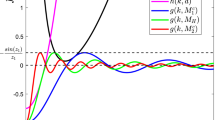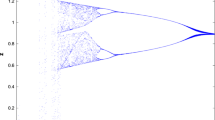Abstract
This paper explores the suitability of space fractional-order reaction–diffusion scenarios to model some emergent pattern formation in predator–prey models. Such fractional reaction–diffusion equations are obtained on the basis of a continuous-time random walk approach with spatial memory and local kinetic reaction. The classical space second-order derivative is changed by the fractional Laplacian case. We employ the Fourier spectral method to numerically approximate the fractional Laplacian and advance in time with the novel ETDRK4 method. In other to obtain guidelines on the correct choice of parameters when numerically simulating the full reaction–diffusion models, the local dynamics of the systems are considered. The biological wave scenarios of solutions are verified by presenting some numerical results in two dimensions to mimic some spatiotemporal dynamics such as spots, stripes and spiral patterns which has a lot of ecological implications.










Similar content being viewed by others
References
Alonso D, Bartumeus F, Catalan J (2002) Mutual interference between predators can give rise to turing spatial patterns. Ecology 83:28–34
Baeumer B, Kovacs M, Meerschaert MM (2007) Fractional reproduction-dispersal equations and heavy tail dispersal kernels. Bull Math Biol 69:2281–2297
Baeumer B, Kovacs M, Meerschaert MM (2008) Numerical solutions for fractional reaction-diffusion equations. Comput Math Appl 55:2212–2226
Berryman AA (1981) Population systems: a general introduction. Plenum Press, New York
Cantrell RS, Cosner C (2003) Spatial ecology via reaction-diffusion equations. Wiley, Indianapolis
Cooper SB, Maini PK (2012) The mathematics of nature at the Alan Turing centenary. Interface Focus 2:393–396
Cox SM, Matthews PC (2002) Exponential time differencing for stiff systems. J Comput Phys 176:430–455
Crampin EJ, Gaffney EA, Maini PK (1999) Reaction and diffusion on growing domains: scenarios for robust pattern formation. Bull Math Biol 61:1093–1120
Crampin EJ, Gaffney EA, Maini PK (2002) Mode-doubling and tripling in reaction-diffusion patterns on growing domains: a piecewise linear model. J Math Biol 44:107–128
Datsko B, Kutnlv M, Wloch A (2020) Mathematical modelling of pattern formation in activator-inhibitor reaction-diffusion systems with anomalous diffusion. J Math Chem 58:612–631
Diethelm K (1997) An algorithm for the numerical solution of differential equations of fractional order. Electron Trans Numer Anal 5:1–6
Diethelm K, Ford NJ, Freed AD (2002) A predictor-corrector approach for the numerical solution of fractional differential equations. Nonlinear Dyn 29:3–22
Diethelm K (2010) The Analysis of Fractional Differential Equations: An Application-oriented Exposition using Differential Operators of Caputo type, Springer Lecture Notes in Mathematics. Springer, Berlin Heidelberg
Dubey B, Kumari N, Upadhyay RK (2009) Spatiotemporal pattern formation in a diffusive predator- prey system: an analytical approach. J Appl Math Comput 31:413–432
Dulos E, Boissonade J, Perraud JJ, Rudovics B (1996) Chemical morphogenesis: turing patterns in an experimental chemical systems. Acta Biotheor 44:249–261
Fisher RA (1937) The wave of advance of advantageous genes. Ann Eugen 7:353–369
Gakkhar S, Naji RK (2005) Order and chaos in \(s\) food web consisting of a predator and two independent preys. Commun Nonlinear Sci Numer Simul 10:105–120
Garrappa R, Popolizio M (2011) Generalized exponential time differencing methods for fractional order problems. Comput Math Appl 62:876–890
Garvie M (2007) Finite-difference schemes for reaction-diffusion equations modeling predator-pray interactions in MATLAB. Bull Math Biol 69:931–956
Garvie M, Trenchea C (2010) Spatiotemporal dynamics of two generic predator-prey models. J Biol Dyn 4:559–570
Henry BI, Wearne SL (2000) Fractional reaction-diffusion. Phys A 276:448–455
Henry BI, Wearne SL (2002) Existence of turing instabilities in a two-species fractional reaction-diffusion system. SIAM J Appl Math 62:870–887
Henry BI, Langlands TAM, Wearne SL (2005) Turing pattern formation in fractional activator-inhibitor systems. Phys Rev E 72:026101
Hoyle RB (2006) Pattern formation: an introduction to methods. Cambridge University Press, Cambridge
Kassam AK, Trefethen LN (2005) Fourth-order time-stepping for stiff PDEs. SIAM J Sci Comput 26:1214–1233
Kilbas AA, Srivastava HM, Trujillo JJ (2006) Theory and applications of fractional differential equations. Elsevier, Netherlands
Kolmogorov A, Petrovsky I, Piskunov N (1937) Investigation of the equation of diffusion combined with increasing of the substance and its application to a biology problem. Mosc Univ Bull Math 1:1–25
Krogstad S (2005) Generalized integrating factor methods for stiff PDEs. J Comput Phys 203:72–88
Kumar S, Kumar A, Abbas S, Al Qurash M, Baleanu D (2020) A modified analytical approach with existence and uniqueness for fractional Cauchy reaction-diffusion equations. Adv Differ Equ 2020:8
Li CP, Wang YH (2009) Numerical algorithm based on Adomian decomposition for fractional differential equations. Comput Math Appl 57:1672–1681
Maini PK, Painter KJ, Chau HNP (1997) Spatial pattern formation in chemical and biological systems. J Chem Soc Faraday Trans 93:3601–3610
McGehee EA, Peacock-López E (2005) Turing patterns in a modified Lotka–Volterra model. Phys Lett A 342:90–98
Meerschaert MM, Tadjeran C (2006) Finite difference approximations for two-sided space-fractional partial differential equations. Appl Numer Math 56:80–90
Meerschaert MM, Scheffler HP, Tadjeran C (2006) Finite difference methods for two-dimensional fractional dispersion equation. J Comput Phys 211:249–261
Méndez V, Fedotov S, Horsthemke W (2010) Reaction-transport systems: mesoscopic foundations, fronts, and spatial instabilities. Springer, Heidelberg
Miller KS, Ross B (1993) An introduction to the fractional calculus and fractional differential equations. Wiley, New York
Morozov A, Petrovskii S (2009) Excitable population dynamics, biological control failure, and spatiotemporal pattern formation in a model ecosystem. Bull Math Biol 71:863–887
Murray JD (2002) Mathematical biology I: an introduction. Springer, New York
Murray JD (2003) Mathematical biology II: spatial models and biomedical applications. Springer, New York
Owolabi KM, Patidar KC (2014) Higher-order time-stepping methods for time-dependent reaction-diffusion equations arising in biology. Appl Math Comput 240:30–50
Owolabi KM, Patidar KC (2014) Numerical solution of singular patterns in one-dimensional Gray-Scott-like models. Int J Nonlinear Sci Numer Simul 15:437–462
Owolabi KM (2015) Robust IMEX schemes for solving two-dimensional reaction-diffusion models. Int J Nonlinear Sci Numer Simul 16:271–284
Owolabi KM, Patidar KC (2016) Numerical simulations of multicomponent ecological models with adaptive methods. Theor Biol Med Modell 13(1):1–25
Owolabi KM (2016) Mathematical analysis and numerical simulation of patterns in fractional and classical reaction-diffusion systems. Chaos Solitons Fractals 93:89–98
Owolabi KM (2016) Mathematical study of two-variable systems with adaptive Numerical methods. Numer Anal Appl 9:218–230
Owolabi KM (2017) Robust and adaptive techniques for numerical simulation of nonlinear partial differential equations of fractional order. Commun Nonlinear Sci Numer Simul 44:304–317
Owolabi KM (2019) Computational study of multi-species fractional reaction-diffusion system with ABC operator. Chaos Solitons Fractals 128:280–289
Owolabi KM (2019) Numerical simulation of fractional-order reaction-diffusion equations with the Riesz and Caputo derivatives. Neural Comput Appl 34:4093–4104
Owolabi KM, Atangana A (2019) Numerical methods for fractional differentiation. Springer, Singapore
Owolabi KM, Karaagac B (2020) Chaotic and spatiotemporal oscillations in fractional reaction-diffusion system. Chaos Solitons Fractals 141:110302
Owolabi KM, Karaagac B (2020) Dynamics of multi-pulse splitting process in one-dimensional Gray-Scott system with fractional order operator. Chaos Solitons Fractals 136:109835
Owolabi KM (2020) High-dimensional spatial patterns in fractional reaction-diffusion system arising in biology. Chaos Solitons Fractals 134:109723
Pearson JE (1993) Complex patterns in a simple system. Science 261:189–192
Petrovskii S, Kawasaki K, Takasu F, Shigesada N (2001) Diffusive waves, dynamic stabilization and spatio-temporal chaos in a community of three competitive species. Jpn J Ind Appl Math 18:459–481
Petrovskii SV, Malchow H (1999) A minimal model of pattern formation in a prey-predator system. Math Comput Modell 29:49–63
Petrovskii SV, Malchow H (2001) Wave of chaos: new mechanism of pattern formation in spatio-temporal population dynamics. Theor Popul Biol 59:157–174
Pindza E, Owolabi KM (2016) Fourier spectral method for higher order space fractional reaction-diffusion equations. Commun Nonlinear Sci Numer Simul 40:112–128
Podlubny I (1999) Fractional differential equations. Academic Press, San Diego
Samko S, Kilbas A, Marichev O (1993) Fractional integrals and derivatives: theory and applications. Gordon and Breach, Amsterdam
Satnoianu RA, Menzinger M, Maini PK (2000) Turing istabilities in general systems. J Math Biol 41:493–512
Somathilake LW, Burrage K (2018) A space-fractional-reaction-diffusion model for pattern formation in coral reefs. Cogent Math Stat 5:1426524
Tadjeran C, Meerschaert MM (2007) A second order accurate numerical method for the two-dimensional fractional diffusion equation. J Comput Phys 220:813–823
Tsyganov M, Biktashev V (2014) Classification of wave regimes in excitable systems with linear cross diffusion. Phys Rev E 90:062912
Turing AM (1952) The chemical basis for morphogenesis. Philos Trans R Soc 237:37–72
Volpert V, Petrovskii S (2009) Reaction-diffusion waves in biology. Phys Life Rev 6:267–310
Wang W, Liu Q-X, Jin Z (2007) Spatiotemporal complexity of a ratio-dependent predator-prey system. Phys Rev E 75:051913
Yildirim A (2009) Application of He’s homotopy perturbation method for solving the Cauchy reaction-diffusion problem. Comput Math Appl 57:612–618
Zhang T, Xing Y, Zang H, Han M (2014) Spatio-temporal dynamics of a reaction-diffusion system for a predator-prey model with hyperbolic mortality. Nonlinear Dyn 78:265–277
Acknowledgements
The authors are grateful to all of the anonymous reviewers for their valuable suggestions
Author information
Authors and Affiliations
Contributions
All authors contributed equally.
Corresponding author
Ethics declarations
Conflict of interest
The authors have no competing interests
Additional information
Publisher's Note
Springer Nature remains neutral with regard to jurisdictional claims in published maps and institutional affiliations.
Rights and permissions
About this article
Cite this article
Owolabi, K.M., Karaagac, B. & Baleanu, D. Dynamics of pattern formation process in fractional-order super-diffusive processes: a computational approach. Soft Comput 25, 11191–11208 (2021). https://doi.org/10.1007/s00500-021-05885-0
Accepted:
Published:
Issue Date:
DOI: https://doi.org/10.1007/s00500-021-05885-0




